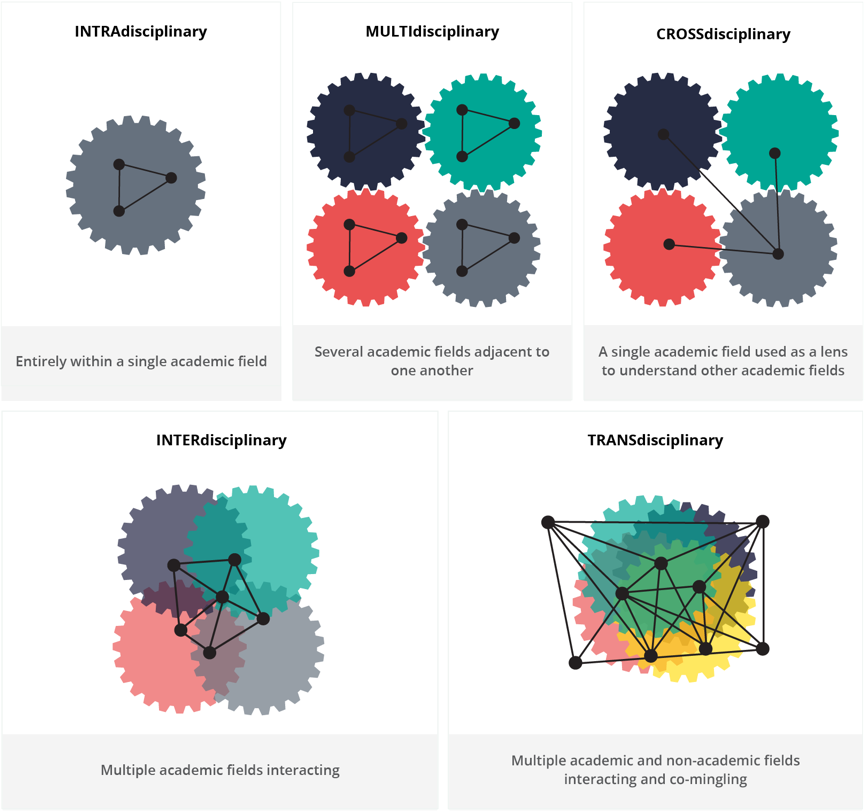The difference between the disciplinarities
Great question, and for budding college students, or established academics working in any field, there are important distinctions to make amongst the terms intra-, multi-, cross-, inter- and trans-disciplinary. It is valuable to evaluate these differences because what you study is not necessarily the only thing you will or can do in your professional life; it’s great to identify the different ways in which subjects and topics meet and meld.
Before we dive into nuances and intricacies, let’s define discipline:
| ˈdɪsɪplɪn |
1. The organisation of learning and the systematic
production of new knowledge.i
2. A particular area of study, especially a subject of
study in a college or university.ii
3. A branch of knowledge, taught and researched as
part of higher education.iii
While the concept of “discipline” has traditionally been used to describe distinct academic specializations, it is important to understand that the nature, breadth, depth, extent and duration of interactions amongst these specializations can ebb and flow over time. It is these interfaces and integrations that sit at the core of innovation, progress, and eventually, professional options in the future.
To begin our exploration, it’s important to recognize that the central questions we need to answer involves intent - where are you starting from and what is your end goal?
Intra-disciplinary
An intra-disciplinary approach involves working within the bounds of a singular discipline. While collaboration is relevant to intra-disciplinary research, it is contingent on the extent of the research question posed.
Consider this example: An applied mathematician may consult statisticians or pure mathematicians when creating a data model to predict weather patterns. That model may then be used in a proposal for a new regional airport. The field of reference in creating the model is entirely mathematical, and in an intra-disciplinary story, it remains only mathematical.
 Photo by Manfred Irmer from Pexels
Photo by Manfred Irmer from Pexels
Multi-disciplinary
A multi-disciplinary approach extracts knowledge from two or more disciplines - which is to say, two or more ways of thinking, or two or more areas of knowledge. This knowledge doesn’t necessarily need to be fused or homogenized; instead, the multi-disciplinary approach focuses on juxtaposition. It could look like a flat-lay of information that functions on parallel planes that do not intersect or interact.
For instance, when conducting quantitative research about social media usage in young adults, a researcher would use mathematics to consolidate data, but that does not mean the research is about mathematics. Here, sociology and mathematics merely sit next to each other but don’t actually interact.
In a multi-disciplinary approach, the mathematician who creates the airport weather data model may present his findings in a meeting that includes pilots, petroleum engineers and emergency response professionals so that each stakeholder can understand the impact of weather on her area of expertise. Weather patterns may impact proposed runway orientation, placement of refueling blocks or movement of people and equipment in emergency situations.
 Photo by Skitterphoto from Pexels
Photo by Skitterphoto from Pexels
While a multi-disciplinary approach may seem passive, it does not necessarily mean it is unproductive. A multi-disciplinary review of an issue usually has one of the following objectives:
- To resolve complex, multi-dimensional problems,
- Provide different perspectives on an issue,
- Create comprehensive research questions, or
- Develop consensus definitions and guidelines.
Cross-disciplinary
Cross-disciplinary study involves approaching one discipline through the perspective of another. Understanding various social sciences such as sociology, history and psychology through the perspective of music is a form of cross-disciplinary study. A specific example might be the influence of jazz music on African-American culture.
According to Rick Szostak, professor of economics at the University of Alberta in Canada, cross-disciplinary approaches involve activities that are assembled with the intent to identify adjacencies when developing an understanding of a topic or issue. For example, to fully understand an abstract topic such as social inclusion, a researcher may have to study anthropological intricacies that fall into grey areas.
 Photo by Skitterphoto from Pexels
Photo by Skitterphoto from Pexels
In a cross-disciplinary approach, the airport weather data model could be used by the airport’s general manager to determine how to move different types of users – pilots, passengers, security officers, and food service employees – through the airport and its adjoining structures efficiently, safely and securely. Each group has different patterns of usage and varying requirements so the manager must be able to identify the impact of weather on optimal procedures and placement of facilities.
Inter-disciplinary
Inter-disciplinary studies emerge as a result of problems that are too wide to be answered within the confines of a singular area of knowledge. In other words, inter-disciplinary studies aim to answer questions that don’t necessarily have black and white answers. For example, the social science field peace and conflict studies relies on a thorough understanding of philosophy, psychology, and other sub-specialties such as migration and development, as well as the evolving ways in which these disciplines interact with each other.
Another example is the intersection between science and literature that manifests in science fiction or sci-fi novels. Or it could be the mix between psychology and biology, wherein the workings of the brain and body help explain why humans act the way they do, with respect to hormones or neurons in the brain. This integration of different fields of study can present a problem or phenomenon in a more holistic manner.
In an inter-disciplinary approach, the airport weather data model could be used by architects, sociologists, economists and food technologists to determine the ideal combination of food and beverage offerings, price points and spots to maximize economic activity, depending on if the airport is located in a cold or tropical climate.
 Photo by Skitterphoto from Pexels
Photo by Skitterphoto from Pexels
Trans-disciplinary
Transformation and inclusion are key concepts when trying to understand trans-disciplinary discourse. Trans-disciplinarians take from all disciplines, with no hard lines to distinguish between what is academic and what is not. When a common goal is established or problem statement is articulated, all contributors are considered equally valuable.
Stakeholders will work on the same problem, ignoring disciplinary boundaries, eliciting non-traditional perspectives and cross-fertilizing assumptions. This type of collaboration and cooperation usually results in improved models, new techniques or before-unimagined synergies.
In a trans-disciplinary approach, the airport weather data model could be a core resource around which a myriad of stakeholders interacts. Public transport officials, car sharing services, travel agents, architects, engineers, sociologists, economists and so on might review the model and collaboratively determine that what the region actually needs is an integrated travel hub. By working together, they innovate to seamlessly bring air, rail, and road transport under a single roof, thereby reducing traffic congestion, pollution, and commute times.

For one final elucidation, let’s metaphorize the approaches into the act of concocting a soup!

- Intra-disciplinary soup is like a one ingredient broccoli soup(yes, this exists!). It’s light and straightforward - it hits the spot and fills you up.
- Multi-disciplinarians collect the ingredients for a particular soup and place them next to one another based on relevance and utility. They try and figure out what can be done with what they have.
- Cross-disciplinarians prepare the ingredients with an eye towards how flavors will influence one another but don’t necessarily bring them together in reality.
- Inter-disciplinarians combine the ingredients and then add seasoning, integrating different tastes to add depth to their flavor profile. This soup is always new and always evolving…not one taken from your grandmother’s recipe book.
- Trans-disciplinarians are the ones who decide to adapt the soup into a broth or a bisque. They also butter some bread…planning ahead, in case diners decide to bring guests.
i What are Academic Disciplines? Some observations on the Disciplinarity vs Interdisciplinarity Debate Krishnan (2009).
ii https://www.collinsdictionary.com/dictionary/english/academic-discipline
iii https://en.wikipedia.org/wiki/Outline_of_academic_disciplines
Naihan Nath contributed to this article
